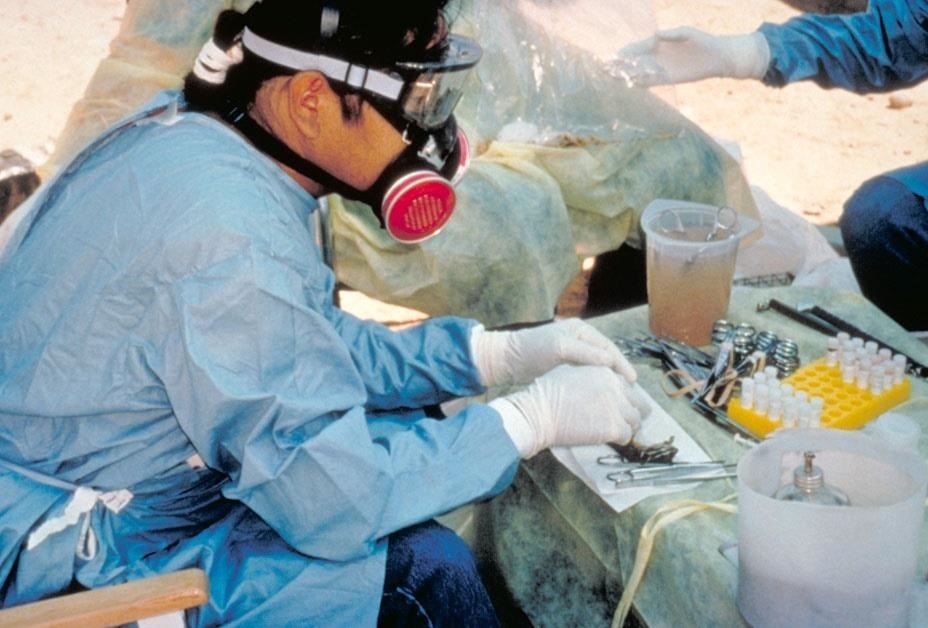A recent pathogen outbreak in Illinois is just one of many outbreaks of an underappreciated, but serious, viral infection passed from rodents to humans. These hantaviruses have been cropping up more frequently in the last decade or so, giving us more reason to clean out our dusty attics, basements, and garages.
In December 2016, eight people were infected by the Seoul virus, a virus in the Hantavirus genus of pathogens. This virus is carried and transmitted by rodents like mice, voles, and domestic and wild rats.
Hantaviruses travel with its carriers. Because the rodent reservoirs that carry hantaviruses, like the Seoul virus, are mobile, so is the virus. Although they cause chronic infection in these animals, hantaviruses don't cause significant symptoms in the rodents that carry them. For humans, the story is different.
Most people had not heard of the Seoul virus before the December outbreak. Two people who run a rat-breeding operation out of their home in Wisconsin came down with symptoms later identified through blood tests as the Seoul virus. Eventually, another six victims of the virus were identified in Illinois. Although one was hospitalized, they've all now recovered.
Hantaviruses are transmitted through the bite of a rodent, or by handling their body products, like saliva, feces, or urine. Since rodents live in the dark, untended parts of our houses, their body products can build up and get in the dust we breathe in. The viruses are also commonly inhaled when dusty viral material is stirred up and floats in the air. This occurs when unused structures, like outbuildings, cabins, or barns inhabited by rodents, are aired out and cleaned.

The victims of this outbreak were pretty lucky, since hantaviruses can be progressive and sometimes fatal. Types of infections associated with hantaviruses include:
- Hantavirus pulmonary syndrome (HPS): Found more commonly in agricultural, forestry, or rural settings, HPS causes a variety of symptoms that could be mistaken for the flu, such as aches, fever, fatigue, and chills. About ten days after onset, breathing becomes short, labored, and interspersed with coughing as the lungs fill with fluid. The fatality rate is almost 40% of victims. In the US, those who clean mice and rat infested buildings and outbuildings, outdoor and forestry workers, and hikers or campers, are most likely to be infected by HPS.
- Hemorrhagic fever with renal syndrome (HFRS): The type of virus that causes hantavirus pulmonary syndrome is not the same that causes hantavirus hemorrhagic fever. Fortunately, HFRS is not the form of hantavirus that impacts the US, but it is found throughout Russia, China, Korea, and Asia. Symptoms include sudden pain, headaches, nausea, and vision problems that progress to shock, drop in blood pressure, kidney failure, and leakage of body fluid from the veins. Though caused by a different pathogen, another well-known hemorrhagic fever is Ebola virus.
Hantaviruses in the United States
While the rodent-breeders who were sickened in December 2016 with the Seoul virus did not develop HPS, a migrant farm worker in Colorado was diagnosed with hantavirus pulmonary syndrome just two months earlier. Though hospitalized, the 25-year old man recovered. His infection was traced to rodent-infested living conditions on a farm where he resides with 12 other men in a 1,000 square foot wood frame outbuilding.
In 2012, eight visitors to Yosemite National Park were infected with hantavirus pulmonary syndrome while staying in cabins within the bounds of the park. Three of the victims died.

The first documented outbreak of hantavirus in the US occurred in 1993, in the Southwest region where New Mexico, Utah, Colorado, and Arizona meet, called the Four Corners area.
Impacting a group of Native Americans, the virus was spread through the inhalation of aerosolized feces of deer mice. A local physician contacted health authorities and suggested it was hantavirus, an illness he had seen in Korea in the 1950s, where an outbreak of hemorrhagic fever, caused by a different hantavirus, sickened over 3,000 United Nations troops, killing 10% of its victims.
Even given the difficulty of identifying a pathogen, the Four Corners hantavirus was isolated within months and named Sin Nombre virus (SNV). The virus itself was not new. The unnamed disease had existed within the Native population perhaps as far back as the 1800s. In tribal lore, the Navajo attributed bad luck and illness to mice—the true viral vector.
Between 1993 and 2015, 659 cases of hantavirus pulmonary syndrome were reported in the United States. Of those, 235 people died. States of highest occurrence for hantaviruses include New Mexico, Colorado, Arizona, and California, in that order.
Fortunately, there were no fatalities in the latest hantavirus outbreak. If you raise or keep rodents as pets, remember they shed germs wherever they go. Otherwise, keep garages and outbuildings clean and tight, and steer clear of places where mice might roam.
One of many, the Seoul virus is not new—just the latest hantavirus to remind humans of the seemingly empty, but crowded space we share with microbes.
Just updated your iPhone? You'll find new emoji, enhanced security, podcast transcripts, Apple Cash virtual numbers, and other useful features. There are even new additions hidden within Safari. Find out what's new and changed on your iPhone with the iOS 17.4 update.






























Be the First to Comment
Share Your Thoughts